Optimized Non-Cooperative Spectrum Sensing Algorithm in Cognitive Wireless Sensor Networks
Abstract
1. Introduction
- We present a CWSN architecture based on non-cooperative spectrum sensing, which reduces the computing requirements for nodes and the communication capability of CWSN.
- We propose a spectrum sensing algorithm based on multi-resolution singular spectrum entropy, which can enhance the stability and reliability of communication links between CWSN nodes.
- The proposed algorithm is verified by MATLAB, and the simulation results show that the detection performance of the algorithm is significantly improved compared with the previous algorithm.
2. Related Works
3. System Model
3.1. CWSN Architecture
3.2. Binary Hypothesis Model
3.3. Performance Index
4. Detection Based on Multi-Resolution Singular Spectrum Entropy
4.1. Algorithm Fundamentals
4.1.1. Wavelet Packet Decomposition
4.1.2. Singular Spectrum Entropy
4.2. Proposed Algorithm
| Algorithm 1 Spectrum sensing algorithm with multi-resolution singular spectral entropy | |
| Input: Network parameters, decision threshold () and sampled data | |
| Output: The state of the channel perceived by the spectrum sensing algorithm () | |
| 1: | Initialization, parameter setting: |
| 2: | for alldo |
| 3: | calculate wavelet packet coefficients: , i = 1, 2, …, 2J |
| 4: | for all do |
| 5: | calculate the singular spectral entropy: |
| 6: | end for |
| 7: | for all do |
| 8: | |
| 9: | end for |
| 10: | |
| 11: | if then |
| 12: | return: |
| 13: | Else |
| 14: | return: |
| 15: | end if |
| 16: | end for |
5. Detection Threshold
6. Simulation Results
7. Discussion and Conclusions
Author Contributions
Funding
Conflicts of Interest
References
- Akan, O.; Karli, O.; Ergul, O. Cognitive radio sensor networks. IEEE Netw. 2009, 23, 34–40. [Google Scholar] [CrossRef]
- Zahmati, A.S.; Hussain, S.; Fernando, X.; Grami, A. Cognitive Wireless Sensor Networks: Emerging topics and recent challenges. In Proceedings of the 2009 IEEE Toronto International Conference Science and Technology for Humanity (TIC-STH), Toronto, ON, Canada, 26–27 September 2009; pp. 593–596. [Google Scholar]
- Yau, K.-L.A.; Komisarczuk, P.; Teal, P.D. Cognitive Radio-based Wireless Sensor Networks: Conceptual design and open issues. In Proceedings of the 2009 IEEE 34th Conference on Local Computer Networks, Zurich, Switzerland, 20–23 October 2009; IEEE: Piscataway, NJ, USA, 2009; pp. 955–962. [Google Scholar]
- Ahmad, A.; Ahmad, S.; Rehmani, M.H.; Hassan, N.U. A Survey on Radio Resource Allocation in Cognitive Radio Sensor Networks. IEEE Commun. Surv. Tutor. 2015, 17, 888–917. [Google Scholar] [CrossRef]
- Zhang, F.; Jing, T.; Huo, Y.; Ma, L. Optimal Spectrum Sensing-Access Policy in Energy Harvesting Cognitive Radio Sensor Networks. Procedia Comput. Sci. 2018, 129, 194–200. [Google Scholar] [CrossRef]
- Zhang, D.; Chen, Z.; Ren, J.; Zhang, N.; Awad, M.K.; Zhou, H.; Shen, X.S. Energy-Harvesting-Aided Spectrum Sensing and Data Transmission in Heterogeneous Cognitive Radio Sensor Network. IEEE Trans. Veh. Technol. 2017, 66, 831–843. [Google Scholar] [CrossRef]
- Aslam, S.; Ejaz, W.; Ibnkahla, M. Energy and Spectral Efficient Cognitive Radio Sensor Networks for Internet of Things. IEEE Internet Things J. 2018, 5, 3220–3233. [Google Scholar] [CrossRef]
- Ren, J.; Zhang, Y.; Zhang, N.; Zhang, D.; Shen, X. Dynamic Channel Access to Improve Energy Efficiency in Cognitive Radio Sensor Networks. IEEE Trans. Wirel. Commun. 2016, 15, 3143–3156. [Google Scholar] [CrossRef]
- Shah, G.A.; Akan, O.B. Cognitive Adaptive Medium Access Control in Cognitive Radio Sensor Networks. IEEE Trans. Veh. Technol. 2015, 64, 757–767. [Google Scholar] [CrossRef]
- Maisuria, J.; Mehta, S. An Overview of Medium Access Control Protocols for Cognitive Radio Sensor Networks. Proceedings 2018, 2, 135. [Google Scholar] [CrossRef]
- Nadeem, A.; Khan, M.; Han, K. Non-cooperative Spectrum Sensing in Context of Primary User Detection: A Review. IETE Tech. Rev. 2017, 34, 188–200. [Google Scholar] [CrossRef]
- Zareei, M.; Islam, A.K.M.M.; Baharun, S.; Vargas-Rosales, C.; Azpilicueta, L.; Mansoor, N. Medium Access Control Protocols for Cognitive Radio Ad Hoc Networks: A Survey. Sensors 2017, 17, 2136. [Google Scholar] [CrossRef]
- Dhope, T.S.; Simunic, D. Performance analysis of covariance based detection in cognitive radio. In Proceedings of the 2012 35th International Convention MIPRO, Opatija, Croatia, 21–25 May 2012; pp. 737–742. [Google Scholar]
- Margoosian, A.; Abouei, J.; Plataniotis, K.N. An Accurate Kernelized Energy Detection in Gaussian and non-Gaussian/Impulsive Noises. IEEE Trans. Signal Process. 2015, 63, 5621–5636. [Google Scholar] [CrossRef]
- Liu, C.; Li, M.; Jin, M. Blind Energy-based Detection for Spatial Spectrum Sensing. IEEE Wirel. Commun. Lett. 2015, 4, 98–101. [Google Scholar] [CrossRef]
- Alkheir, A.A.; Mouftah, H.T. An Improved Energy Detector Using Outdated Channel State Information. IEEE Commun. Lett. 2015, 19, 1237–1240. [Google Scholar] [CrossRef]
- Divakaran, K.; Manikandan, N.; Hari, S. Wavelet Based Spectrum Sensing Techniques for Cognitive Radio—A Survey. Int. J. Comput. Sci. Inf. Technol. 2011, 3, 123–137. [Google Scholar] [CrossRef]
- Zeng, Y.; Liang, Y. Eigenvalue-based spectrum sensing algorithms for cognitive radio. IEEE Trans. Commun. 2009, 57, 1784–1793. [Google Scholar] [CrossRef]
- Du, K.; Mow, W.H. Affordable Cyclostationarity-Based Spectrum Sensing for Cognitive Radio With Smart Antennas. IEEE Trans. Veh. Technol. 2010, 59, 1877–1886. [Google Scholar] [CrossRef]
- Huang, G.; Tugnait, J.K. On Cyclostationarity Based Spectrum Sensing Under Uncertain Gaussian Noise. IEEE Trans. Signal Process. 2013, 61, 2042–2054. [Google Scholar] [CrossRef]
- Oo, T.Z.; Tran, N.H.; Dang, D.N.M.; Han, Z.; Le, L.B.; Hong, C.S. OMF-MAC: An Opportunistic Matched Filter-Based MAC in Cognitive Radio Networks. IEEE Trans. Veh. Technol. 2016, 65, 2544–2559. [Google Scholar] [CrossRef]
- Eduardo, A.F.; Caballero, R.G.G. Experimental evaluation of performance for spectrum sensing: Matched filter vs energy detector. In Proceedings of the IEEE Colombian Conference on Communication and Computing (IEEE COLCOM 2015), Popayan, Colombia, 13–15 May 2015; pp. 1–6. [Google Scholar]
- Ma, L.; Li, Y.; Demir, A. Matched filtering assisted energy detection for sensing weak primary user signals. In Proceedings of the 2012 IEEE International Conference on Acoustics, Speech and Signal Processing (ICASSP), Kyoto, Japan, 25–30 March 2012; pp. 3149–3152. [Google Scholar]
- Ali, A.; Hamouda, W. Advances on Spectrum Sensing for Cognitive Radio Networks: Theory and Applications. IEEE Commun. Surv. Tutor. 2017, 19, 1277–1304. [Google Scholar] [CrossRef]
- Zhang, X.; Chai, R.; Gao, F. Matched filter based spectrum sensing and power level detection for cognitive radio network. In Proceedings of the 2014 IEEE Global Conference on Signal and Information Processing (GlobalSIP), Atlanta, GA, USA, 3–5 December 2014; pp. 1267–1270. [Google Scholar]
- Nasser, A.; Mansour, A.; Yao, K.C.; Charara, H.; Chaitou, M. Efficient spectrum sensing approaches based on waveform detection. In Proceedings of the The Third International Conference on e-Technologies and Networks for Development (ICeND2014), Beirut, Lebanon, 29 April–1 May 2014; pp. 13–17. [Google Scholar]
- Sepidband, P.; Entesari, K. A CMOS Spectrum Sensor Based on Quasi-Cyclostationary Feature Detection for Cognitive Radios. IEEE Trans. Microw. Theory Tech. 2015, 63, 4098–4109. [Google Scholar] [CrossRef]
- Sobron, I.; Diniz, P.S.R.; Martins, W.A.; Velez, M. Energy Detection Technique for Adaptive Spectrum Sensing. IEEE Trans. Commun. 2015, 63, 617–627. [Google Scholar] [CrossRef]
- Dikmese, S.; Sofotasios, P.C.; Renfors, M.; Valkama, M. Subband Energy Based Reduced Complexity Spectrum Sensing Under Noise Uncertainty and Frequency-Selective Spectral Characteristics. IEEE Trans. Signal Process. 2016, 64, 131–145. [Google Scholar] [CrossRef]
- Takens, F. On the numerical determination of the dimension of an attractor. In Dynamical Systems and Bifurcations; Braaksma, B.L.J., Broer, H.W., Takens, F., Eds.; Springer: Berlin/Heidelberg, Germany, 1985; pp. 99–106. [Google Scholar]
- Vautard, R.; Ghil, M. Singular spectrum analysis in nonlinear dynamics, with applications to paleoclimatic time series. Phys. D Nonlinear Phenom. 1989, 35, 395–424. [Google Scholar] [CrossRef]
- Yang, F.; Sheng, G.; Xu, Y.; Qian, Y.; Jiang, X. Application of EEMD and high-order singular spectral entropy to feature extraction of partial discharge signals. IEEJ Trans. Electr. Electron. Eng. 2018, 13, 1002–1010. [Google Scholar] [CrossRef]

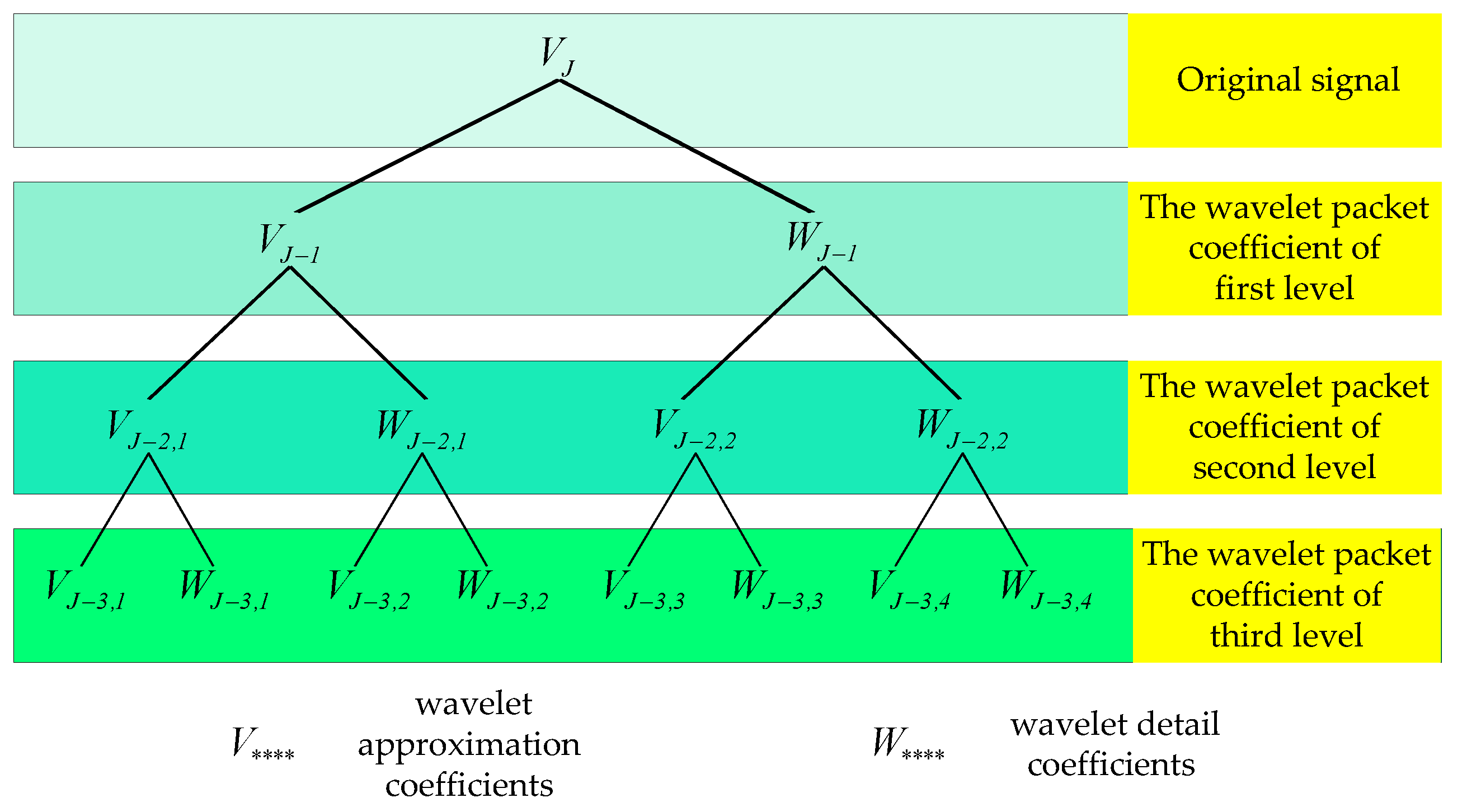
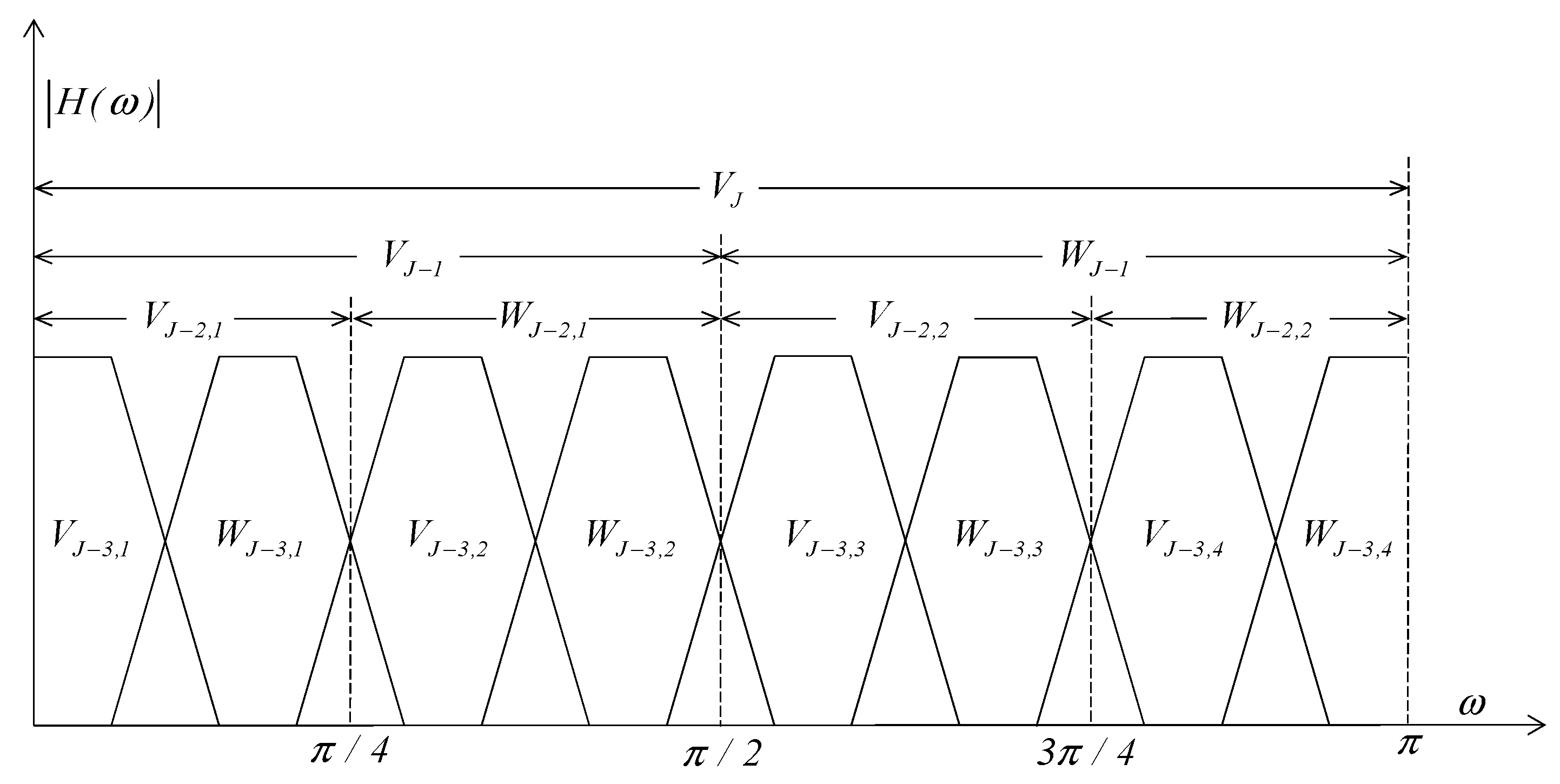

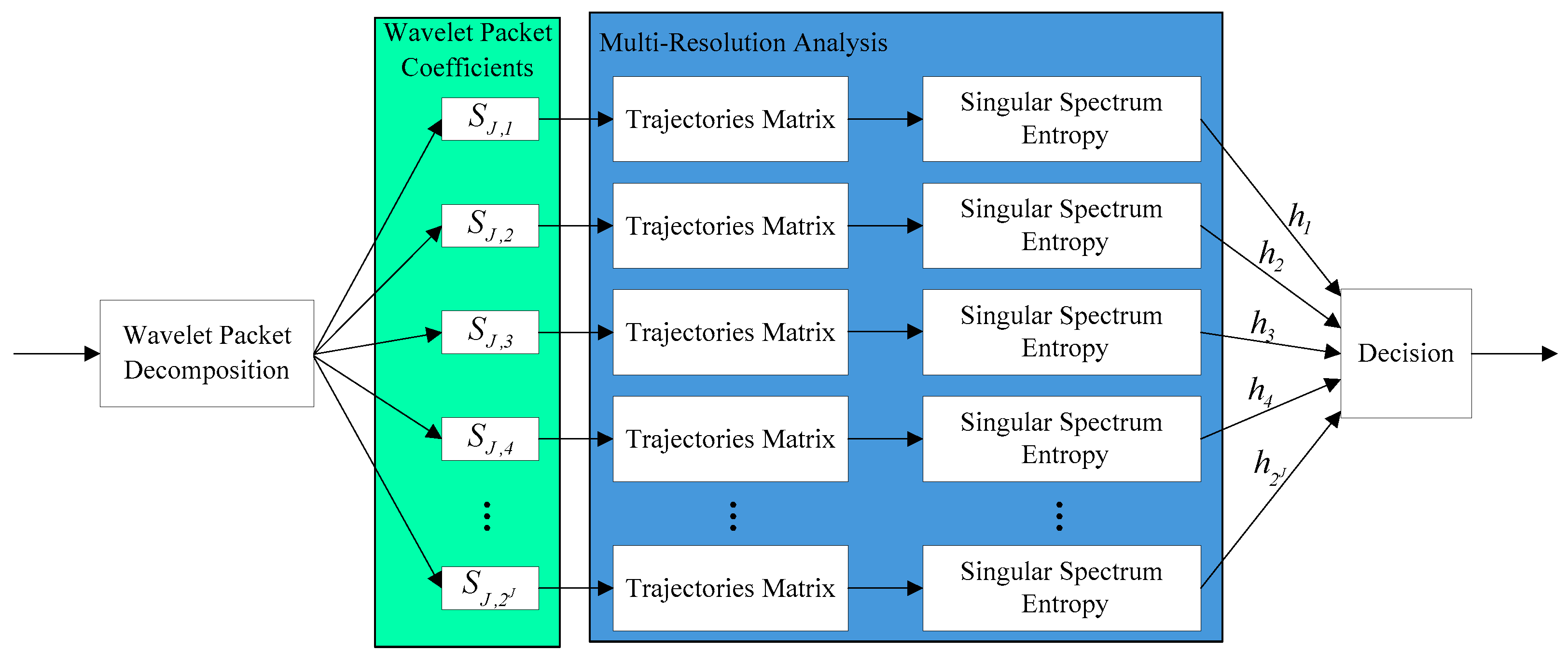




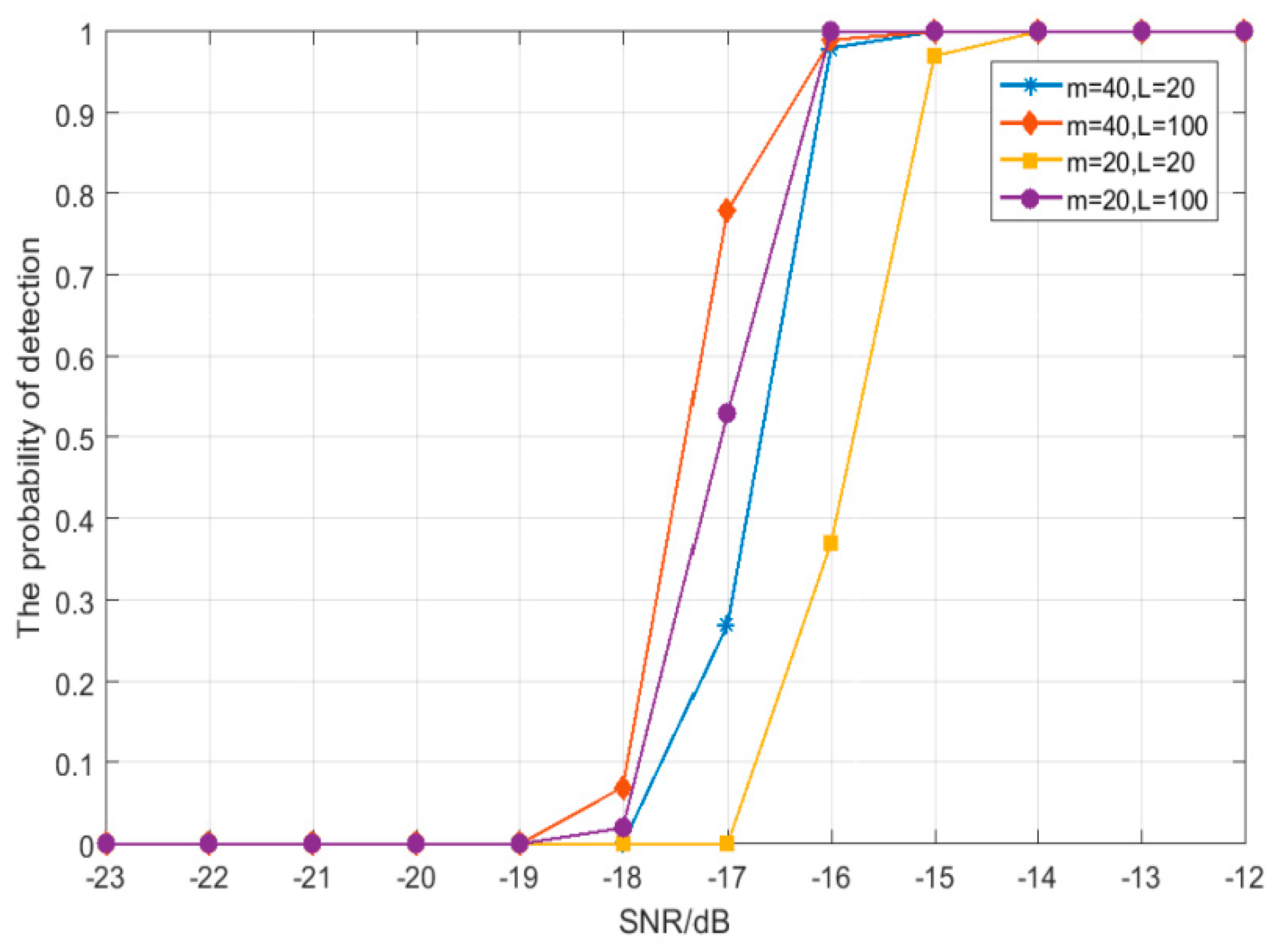
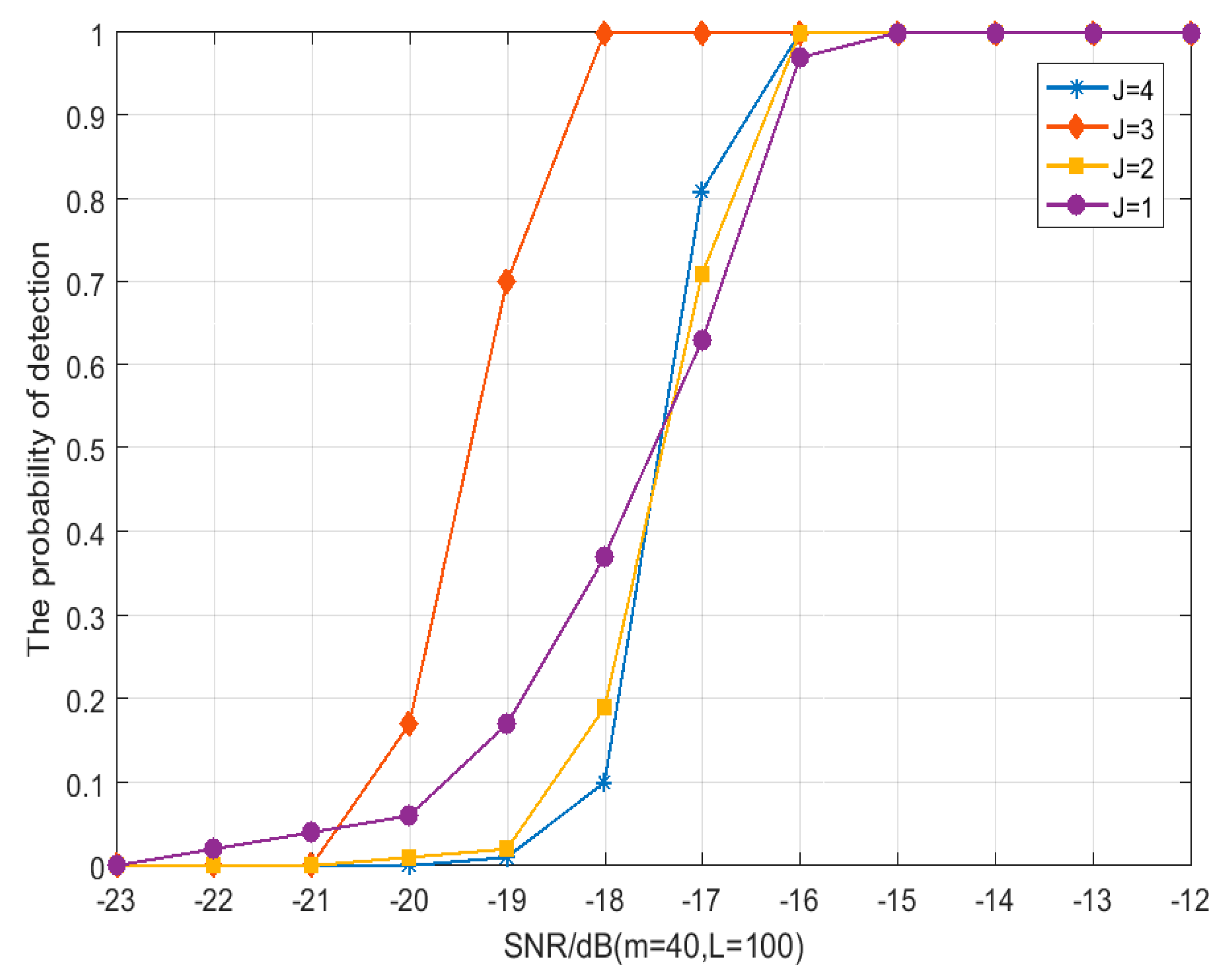

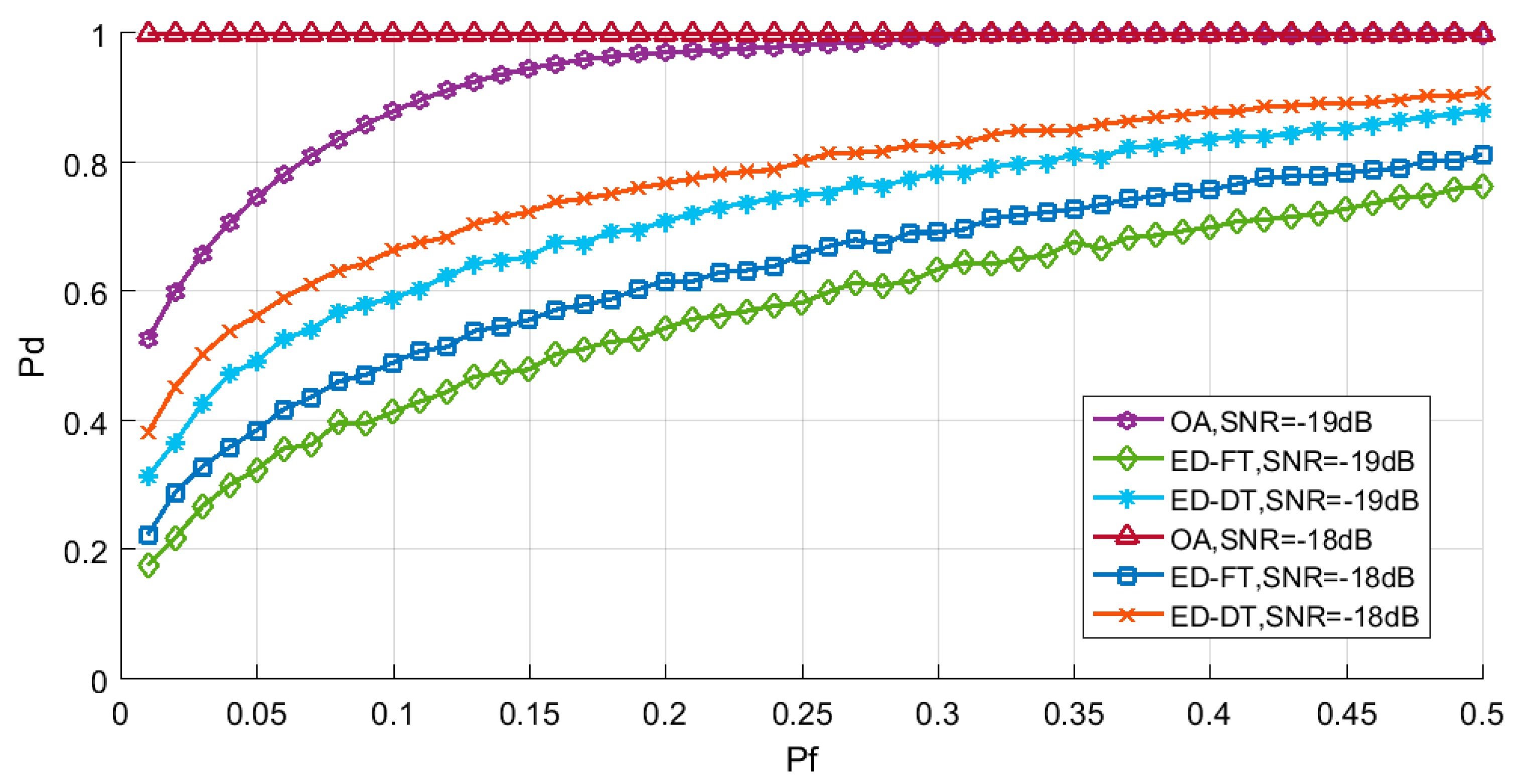
| Sensing Technique | Advantages | Limitations | Relevant Recent References |
|---|---|---|---|
| Energy Detector | ● Does not require prior knowledge about the primary network ● Simple to design, implement, and has less complexity | ● Cannot discriminate between primary signal and noise ● Cannot perform well for low SNR ● Vulnerable to noise uncertainty | [13,14,15,16,28,29] |
| Feature Detection | ● Sensing performance is highly reliable, can detect signals with low SNR ● Robust to noise uncertainty | ● Prior knowledge of the primary network ● Higher accuracy requires a longer length of known sequences that results in lower efficiency of the spectrum ● Slower sensing compared to energy detection | [17,18,19,20,26,27] |
| Matched Filter | ● Optimal sensing performance, maximizes the received SNR ● Less time needed to achieve high processing gain | ● Prior knowledge of the primary network ● Computational complexity depends on the primary network ● Dedicated sensing receiver required for synchronization at each SU | [21,22,23,25] |
| K | ||||||||
|---|---|---|---|---|---|---|---|---|
| 0.995 | 0.95 | 0.9 | 0.85 | 0.15 | 0.1 | 0.05 | 0.005 | |
| 1 | … | … | 0.02 | 0.04 | 2.07 | 2.71 | 3.84 | 7.88 |
| 3 | 0.07 | 0.35 | 0.58 | 0.80 | 5.32 | 6.25 | 7.81 | 12.84 |
| 7 | 0.99 | 2.17 | 2.83 | 3.36 | 10.75 | 12.02 | 14.07 | 20.28 |
| 15 | 4.60 | 7.26 | 8.55 | 7.90 | 20.60 | 22.31 | 25.00 | 32.80 |
© 2019 by the authors. Licensee MDPI, Basel, Switzerland. This article is an open access article distributed under the terms and conditions of the Creative Commons Attribution (CC BY) license (http://creativecommons.org/licenses/by/4.0/).
Share and Cite
Chen, Y.; Su, S.; Yin, H.; Guo, X.; Zuo, Z.; Wei, J.; Zhang, L. Optimized Non-Cooperative Spectrum Sensing Algorithm in Cognitive Wireless Sensor Networks. Sensors 2019, 19, 2174. https://doi.org/10.3390/s19092174
Chen Y, Su S, Yin H, Guo X, Zuo Z, Wei J, Zhang L. Optimized Non-Cooperative Spectrum Sensing Algorithm in Cognitive Wireless Sensor Networks. Sensors. 2019; 19(9):2174. https://doi.org/10.3390/s19092174
Chicago/Turabian StyleChen, Yangyi, Shaojing Su, Huiwen Yin, Xiaojun Guo, Zhen Zuo, Junyu Wei, and Liyin Zhang. 2019. "Optimized Non-Cooperative Spectrum Sensing Algorithm in Cognitive Wireless Sensor Networks" Sensors 19, no. 9: 2174. https://doi.org/10.3390/s19092174
APA StyleChen, Y., Su, S., Yin, H., Guo, X., Zuo, Z., Wei, J., & Zhang, L. (2019). Optimized Non-Cooperative Spectrum Sensing Algorithm in Cognitive Wireless Sensor Networks. Sensors, 19(9), 2174. https://doi.org/10.3390/s19092174





